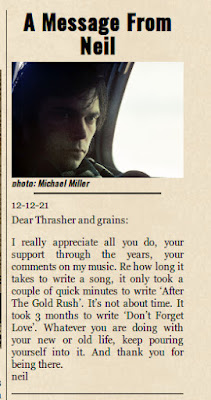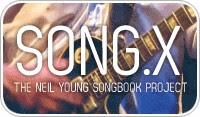The Story Behind The Photo: "Neil Young in the Big Chair" by Tom Wilkes
This is one of the very few photos to exist of Danny Whitten, the guitarist in Neil Young's band Crazy Horse.

(see Remembering Danny Whitten: 1943 - 1972)
Back to the Decade album and Tom Wilkes. Tom Wilkes was the art director, album cover designer, and photographer for the Decade album, as well as, other Neil Young albums such as “Harvest”.
As we investigated back in 2017 on The Images Behind The Album Cover of Neil Young's Decade, who is on the cover behind the guitar case? The long time story has been that it was Neil's girlfriend Carrie Snodgress, out in the desert. However, upon closer look below, it does not appear to be Carrie at all.
Upon doing a little more research, from "Shakey" by Jimmy McDonough: "The packaging was great - wry notes on each song handwritten by Young himself, and a cover photo obscure even by Young's standards - the girlfriend of art director Tom Wilkes standing out in the desert, balancing a well-traveled guitar case on her back."
From Mr Music Head (Thanks Mother Nature on the Run!):
Tom Wilkes was an art director, album cover designer, and photographer who blazed a graphic trail throughout the 60s, 70s and 80s, creating high concept visual statements that have become iconic cultural artifacts. A graduate of Art Center, he got his start pinstriping hot rods and motorcycles in the 50s before opening his own design studio in Long Beach and moving into record company work with an album for The Coasters. His covers include “Flowers” and “Beggars’ Banquet” for the Stones, the stairwell albums for the Beatles, “All Things Must Pass” and “Living In The Material World” for George Harrison, “Harvest” and “Decade” for Neil Young, the whiteface album for Ike & Tina Turner, and many, many more.
In 1967, as art director for the Monterey Pop Festival, Tom was given a painting by The Beatles, a work that has since become known as “The Dead Sea Scroll Of Rock And Roll.” In the late-70s, he became friends with John and Toni Lilly who introduced him to the concept of dolphin intelligence. After several profound encounters, Tom created Project Interspeak and spent the rest of his life trying to mount a global concert on behalf of the dolphin nation…with the Beatles’ artwork a possible funding source.
He lived a highly adventurous life filled with wild times and beautiful women, and is celebrated in the memory of those who knew him as one of the great rebellious spirits, and artists, of his time.
David Fricke, a senior writer at Rolling Stone magazine said of Wilkes work that:
"He was able to capture a certain essence of what was on the record and the person who made it.
"You look at something like Neil Young's 'Harvest,' the texture of the cover and that very simple, almost antique lettering, and you get a feel of what Neil was trying to do in that record, the honesty and the grit and the deep Americana of what that record represents now."

Harvest Cover designed by Tom Wilkes
Tom Wilkes, a Grammy Award-winning art director and the album cover designer for Neil Young's Harvest, died in 2009 at age of 69.
Wilkes
design work included album covers for the Rolling Stones' "Beggars
Banquet," Eric Clapton's "Eric Clapton," Joe Cocker's "Mad Dogs &
Englishmen" and George Harrison's "Concert for Bangladesh" and "All
things Must Pass." Wilkes photographed the cover photo of Janice
Joplin's 1971 "Pearl" album. Their photo session was the night Joplin
overdosed.

Tom Wilkes: 1939 - 2009
R.I.P. Tom. We've always admired your work.
Labels: #CrazyHorse4HOF, danny whitten, decade album, neil young, photo, tom wilkes




































 Human Highway
Human Highway

















 Concert Review of the Moment
Concert Review of the Moment





 This Land is My Land
This Land is My Land

 FREEDOM In A New Year
FREEDOM In A New Year









 *Thanks Neil!*
*Thanks Neil!*




![[EFC Blue Ribbon - Free Speech Online]](http://www.thrasherswheat.org/gifs/free-speech.gif)











 The Unbearable Lightness of Being Neil Young
The Unbearable Lightness of Being Neil Young Pardon My Heart
Pardon My Heart



 "We're The Ones
"We're The Ones  Thanks for Supporting Thrasher's Wheat!
Thanks for Supporting Thrasher's Wheat!




 This blog
This blog 
 (... he didn't kill himself either...)
#AaronDidntKillHimself
(... he didn't kill himself either...)
#AaronDidntKillHimself









































































 Neil Young's Moon Songs
Neil Young's Moon Songs




 Civic Duty Is Not Terrorism
Civic Duty Is Not Terrorism Orwell (and Grandpa) Was Right
Orwell (and Grandpa) Was Right


 What's So Funny About
What's So Funny About 



6 Comments:
Wondering, why it isn't mentioned that Tom Wilkes also did the cover art for the Homegrown album: https://neilyoungarchives.com/album?id=A_089&tab=credits
https://www.rusted-moon.com/2020/06/neil-young-homegrown-1975-2020.html
'The cover art of "Homegrown" shows a man with a straw hat and a dog in a rural idyll, biting into an ear of corn. Below that, in addition to the title “Homegrow”, is the saying “Never Known To Fail” - so you can rely on something you grow yourself. The figure with the straw hat that Neil Young claimed to show him has a lot of similarities to Tom Wilkes'
Thanks Gordon. Updated to include Homegrown cover.
So a bit of a self portrait of Wilkes?
This post is a perfect example of why I love Thrasher’s Wheat! What a great post, and quite interesting to me.
So as we sit on the edge of our collective seat, awaiting Neil’s 2024 Summer Tour announcement, I am reminded of how Grateful I am for this blog. Thrasher, thank you SO much for doing it, from one day to the next, season after season, Decade after Decade.
Have a great day y’all, and I hope to see you on the rail soon!
Your Brother Alan in Seattle
Katherine Wilkes Harvill, Tom Wilkes daughter, Speaks on Father & Gram [Parsons & Neil Young while living in Topanga]:
https://www.youtube.com/watch?v=g0OQT1s2T4g
From a post "611 Skyline Trail, Topanga, CA" on the "Neil Young with Crazy Horse...The Neil Young Fan Group" FB:
Katherine Wilkes Harvill [KWH]: Spent so many childhood hours in that house.
JG: when were you there?
KWH: in the 60's when Neil was our neighbor. My dad used to design Neil's album covers.
I sat on the stage at the Troubadour with him at a gig when my dad didn't pick me up on time.
RL: Which album covers did your Dad design if you don't mind me asking?
KWH: Harvest, Decade, Comes a Time
Comes A Time - "Art Direction: Tom Wilkes, Photography: Coley Coleman" - https://neilyoungarchives.com/album?id=A_022&tab=credits
@ Alan - thanks for being here!
@ Gordon - we'll check out the video and post an update next time around.
Nice to see Wilkes getting some well deserved recognition.
All this time, I had forgotten or not considered Whitten in the background. Great photo, a little eerie in hindsight—like Danny is a ghost or specter over Neil’s shoulder. The unspoken presence.
A lovely bonus effect of the vinyl renaissance is the return of album cover art in its original, bigger and more flamboyant form. Tapes, CDs, and downloads had gradually marginalized this dimension into oblivion. On itunes or spotify, an album cover amounts to a thumbnail. On the other hand, things cost money; though I’m not very familiar with the economics of record manufacturing, I would venture to say packaging is often the most expensive component, especially with all the collectors’ bells and whistles now built into the marketing strategy.
Cultural materialists, new historicists, and students of media history should find much to ponder here. I hope there will one day be courses on the history of the vinyl album, as we now have studies on the history of the book as an object.
Post a Comment
<< Home